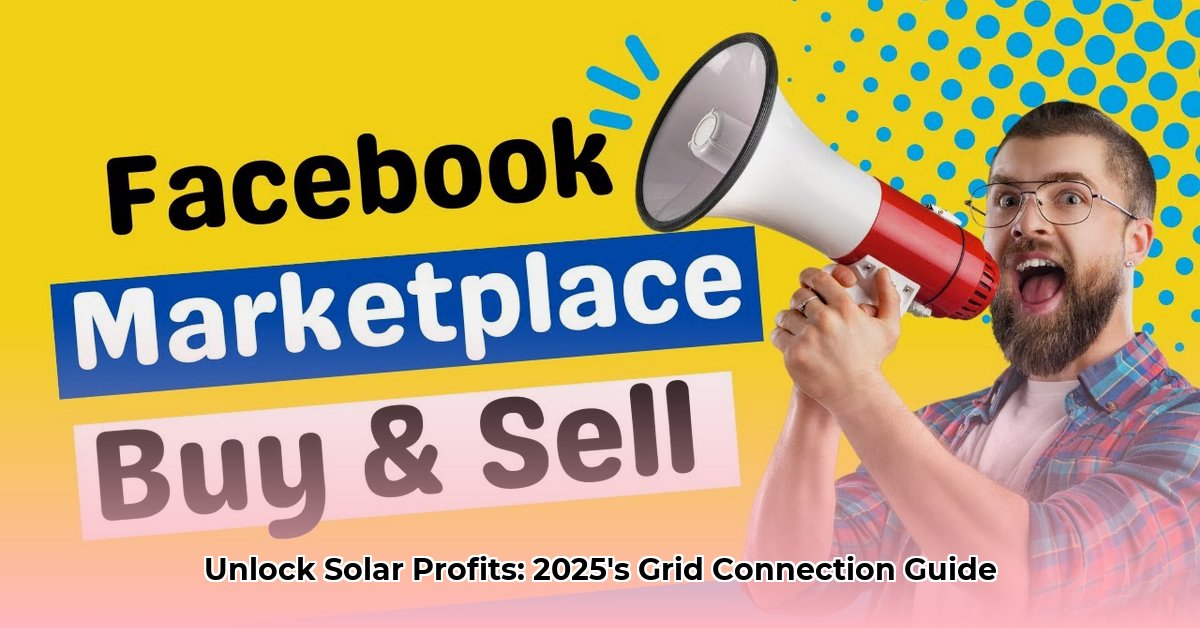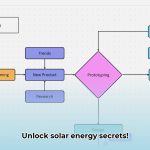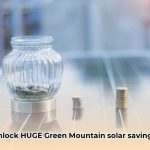Harnessing the sun’s energy with solar panels is a win-win: you shrink your carbon footprint and cut your electricity bills. But what if you could turn your solar panels into a money-making machine? This comprehensive guide reveals how to sell your extra solar energy back to the grid, boosting your income and accelerating your return on investment. Whether you’re a homeowner, a business owner, or simply curious about the solar industry, we’ll equip you with the knowledge to navigate regulations, optimize your system, and maximize your profits. For more on financial aspects, see [solar energy profits](https://txgenco.com/financial-benefits-of-solar-energy). Let’s transform sunlight into savings!
Unleash the Earning Potential of Your Solar Panels
Selling excess solar energy isn’t just about being green; it’s about making smart financial decisions. This guide provides a clear roadmap to successfully selling your solar energy in 2025. While it’s not a path to overnight riches, strategic planning and a thorough understanding of the market can significantly improve your financial outlook.
Navigating the Solar Energy Landscape: Net Metering and Beyond
Net metering is the most prevalent compensation method, where your utility company credits you for surplus solar energy sent back to the grid. While widespread, net metering isn’t the only option. Alternative systems like feed-in tariffs (FITs) and value-of-solar tariffs are emerging. These systems offer diverse payment structures, highlighting the importance of understanding your local options. What are the key factors driving the transition from traditional net metering to alternative compensation mechanisms for solar energy producers?
Step 1: Master Your Local Solar Regulations
- State-Level Research: Begin by investigating your state’s specific regulations regarding solar energy sales. Search online for “[Your State] solar energy buyback program” to find relevant information. This critical step can save you considerable time and frustration.
- Utility Company Consultation: Engage with your local electricity provider to understand their specific requirements for grid connection. Inquire about available programs and incentives that encourage solar energy production.
- Explore Compensation Alternatives: If net metering isn’t optimal in your area, research alternative compensation models like feed-in tariffs or value-of-solar tariffs. Compare financial incentives to determine the most beneficial option.
Solar Panel System Design: Aligning Production with Consumption
Before selling solar energy, ensure your system is designed for maximum efficiency. An oversized system can lead to wasted energy, as you’re only compensated for excess production. The ideal system size should align with your energy consumption and financial goals. What strategies can homeowners employ to reduce their energy consumption and maximize the amount of solar energy available for sale back to the grid?
Step 2: Tailoring Your Solar System Design
- Assess Energy Needs: Analyze your past utility bills to determine your average electricity consumption. This baseline will help you determine the appropriate solar energy production target.
- Optimize System Size: Collaborate with a qualified solar installer to design a system that meets your energy needs while generating a surplus for sale. Your installer can help you balance energy production and potential revenue.
- Evaluate Battery Storage: Consider incorporating battery storage to store excess solar energy for later use, particularly during peak demand periods. This can potentially increase your earnings.
Grid Connection: Understanding and Completing Interconnection Agreements
Selling solar energy necessitates a formal agreement with your utility company for grid connection. This process involves paperwork, inspections, and adherence to technical requirements. Thorough preparation is essential. What are the typical timelines and costs associated with obtaining grid interconnection approval for residential solar systems?
Step 3: Secure Utility Approval
- Submit Interconnection Application: Complete the required online application, providing detailed documentation of your system’s design, specifications, and safety features.
- Undergo System Inspections: Ensure your system meets all safety standards and the utility’s connection requirements. Work closely with your installer to ensure readiness for inspection.
- Sign Interconnection Agreement: Upon successful inspection, sign a formal interconnection agreement with your utility company. Review the contract carefully before committing.
Wholesale Energy Sales: Opportunities for Businesses
Selling excess solar energy as a business differs significantly from residential sales. It requires a strategic business approach and adherence to wholesale market regulations. What are the key differences in regulatory requirements and market dynamics between residential and commercial solar energy sales?
Step 4: Business-Oriented Wholesale Energy Sales
- Research Wholesale Markets: Investigate energy markets in your region to understand the process of selling energy wholesale, which typically involves larger quantities and contractual agreements.
- Network with Potential Buyers: Build relationships with businesses and energy aggregators who may be interested in purchasing your solar energy. Attend industry events and establish connections.
- Develop Pricing Strategies: Create a competitive pricing strategy that considers market rates, production capacity, and operating costs. Focus on long-term financial stability rather than solely pursuing the highest bid.
Financial Risk Assessment: Identifying Potential Challenges
Selling solar energy involves financial considerations and potential risks. Prepare by understanding and mitigating these challenges. What financial tools and incentives are available to mitigate the risks associated with investing in solar energy systems for the purpose of selling excess power back to the grid?
| Risk Factor | Probability | Impact | Mitigation Strategy |
|---|---|---|---|
| Changes to Net Metering Policies | Medium | Reduced/Lost Income | Stay updated on policy changes; explore alternative revenue models (e.g., battery storage, virtual power plants) |
| Equipment Malfunction | Low | Lost Production | Implement regular maintenance; utilize warranties; implement system monitoring; obtain insurance coverage |
| Grid Instability | Low | Damage/Power Outages | Ensure grid compatibility in collaboration with the utility company; install surge protection devices |
| Regulatory Ambiguity | Medium | Delays/Project Halt | Work with experienced consultants knowledgeable about regulatory changes; advocate for clear and consistent policies |
| Weather-Related Damage | Low | Reduced/Lost Production | Secure adequate insurance coverage; design systems to withstand extreme weather events |
| Fluctuations in Energy Prices | Medium | Revenue Uncertainty | Diversify revenue streams (e.g., participating in demand response programs); secure long-term contracts with fixed rates, where possible |
The Future of Solar Energy Sales: Embracing Innovation
The energy landscape is evolving rapidly. Stay informed about emerging trends like smart grids, virtual power plants, and peer-to-peer energy trading to remain competitive. How can blockchain technology be leveraged to facilitate peer-to-peer energy trading and enhance transparency in solar energy sales?
Step 5: Long-Term Strategic Planning
- Monitor System Performance: Track your system’s performance to identify and address issues promptly. Regular maintenance is crucial for sustained efficiency.
- Stay Informed on Policy Updates: Remain vigilant about changes in government regulations and energy market dynamics to adapt your strategies accordingly.
- Explore Emerging Opportunities: Investigate innovative technologies and business models like virtual power plants and advanced energy storage solutions to maximize returns on investment.
Selling solar energy demands careful planning, a thorough understanding of regulations, and adaptability to market changes. By taking a strategic approach, you can transform sunlight into a reliable source of profit.
Virtual Power Plants: Amplifying Your Solar Energy Profits
Key Takeaways:
- Virtual Power Plants (VPPs) represent a promising avenue for increasing solar energy earnings.
- Participation in VPPs requires strategic planning and insights into market dynamics.
- Success depends on technology integration, regulatory compliance, and stakeholder collaboration.
Understanding Virtual Power Plants (VPPs) for Sustainable Energy
Imagine a network connecting numerous individual solar systems, forming a collective energy resource. This is the essence of a VPP, which aggregates excess solar power from homes and businesses, selling it to the grid or using it to meet fluctuating energy demands. Unlocking maximum solar energy profits through virtual power plants depends on strategic leveraging of your energy assets. What are the cybersecurity considerations that solar energy system owners should be aware of when participating in virtual power plants (VPPs)?
Steps to Maximize Solar Power Profits with VPPs
- Evaluate System Suitability: Assess whether your solar array (ideally 7.5kW or higher) and battery storage system are adequately sized. Larger systems generate more surplus energy, increasing your potential earnings.
- Select the Right VPP Program: Research local VPP programs to find the best fit for your system and energy goals. Compare fees, payment structures, and technological compatibility. Some programs focus on energy trading, while others prioritize demand response.
- Optimize Energy Consumption: Utilize smart home devices to strategically manage energy consumption, maximizing the amount of energy available for sale to the VPP. Shift high-energy appliance use to periods of lower solar production.
- Invest in Smart Technology: Implement smart inverters that accurately measure energy production and facilitate seamless energy transfers to the VPP. Explore options that integrate with your home energy management system (HEMS).
- Monitor and Adapt Performance: Continuously track your energy production and VPP performance. Analyze the data to identify areas for improvement and adjust your strategies accordingly. Stay informed about evolving market conditions.
- Plan for Future Expansion: Consider upgrading your system to include advanced features like vehicle-to-grid (V2G) technology to further expand your profit potential.
Financial Considerations & VPP Risks for Solar System Owners
The financial benefits of VPP participation vary significantly based on location, market conditions, and program design. While substantial profits are possible, it’s crucial to understand potential risks. What are the potential implications of participating in demand response programs offered by virtual power plants on the lifespan and performance of home appliances?
Pros:
- Increased revenue streams through the sale of excess solar energy.
- Contribution to grid stability and environmental sustainability.
Cons:
- Initial investment costs for system upgrades (batteries, smart inverters).
- Potential for regulatory changes affecting profitability.
VPP Regulatory Compliance for Solar Power Grid Connection
VPP participation is subject to varying degrees of regulatory oversight. Familiarize yourself with local regulations and utility company policies regarding energy export and VPP participation. Advocate for supportive policies that enhance VPP viability. What strategies can solar energy system owners employ to navigate complex regulatory requirements for virtual power plant (VPP) participation?
Improving VPP Stakeholder Collaboration for Solar Energy Growth
Successful VPP implementation requires coordination among multiple stakeholders. Building strong relationships with your utility company, technology providers, and fellow VPP participants fosters efficiency and ensures mutual profitability. How can standardized communication protocols and data sharing practices improve collaboration among stakeholders in virtual power plants (VPPs)?
[This guide is based on information from various sources. Individual results may vary.]
Strategic Solar Panel Placement: Maximizing Grid Energy Sales
Key Takeaways:
- Strategic solar panel placement significantly impacts energy yield and profitability.
- South-facing (Northern Hemisphere) or north-facing (Southern Hemisphere) installations typically maximize sunlight capture.
- Minimizing shade and optimizing tilt angle are critical for maximizing energy production.
Comprehensive Solar Site Assessment: Foundation for Success
Before installation, conduct a thorough site assessment to lay the groundwork for optimal performance. This involves: How do local climate conditions (e.g., temperature, humidity, snowfall) influence the selection of materials and installation techniques for solar panels?
- Sun Path Analysis: Determine the optimal panel orientation (south-facing in the Northern Hemisphere, north-facing in the Southern Hemisphere) and tilt angle using specialized tools or professional consultation.
- Shading Assessment: Identify and quantify potential shading from trees, buildings, or other structures. Account for seasonal changes in shading patterns.
- Roof Structure Evaluation: Assess the roof’s suitability for solar panel mounting, considering load-bearing capacity and structural integrity. Schedule a roof inspection if necessary.
Solar Panel and Inverter Selection: Optimizing Conversion Efficiency
Select components that maximize energy conversion efficiency. This involves: What are the advantages and disadvantages of using solar trackers to optimize panel orientation compared to fixed-tilt installations?
- Panel Type Selection: Choose the panel type that best suits your needs. Bifacial panels capture additional energy from reflected sunlight but require a higher initial investment. Consider monocrystalline panels for higher efficiency or polycrystalline panels for a more cost-effective option.
- Inverter Selection: Evaluate the performance of micro-inverters versus string inverters, particularly in partially shaded conditions. Micro-inverters often offer superior energy production but may increase initial costs.
- System Sizing: Determine the optimal system size based on your energy needs and anticipated energy production levels to strike a balance between investment and long-term returns.
Navigating the Regulatory Landscape for Grid Connection
Obtain necessary permits and comply with all applicable regulations to ensure a smooth and profitable grid connection. This involves: What are the environmental considerations associated with solar panel manufacturing, installation, and disposal, and how can these impacts be minimized?
- Permitting and Inspections: Familiarize yourself with all relevant local, state, and federal regulations, as these can vary significantly. Delays in permitting can postpone your revenue stream.
- Net Metering and Grid Connection: Understand the net metering policies in your area, as they dictate how you can sell excess energy back to the grid and significantly influence your profitability.
Solar Panel Monitoring and Maintenance: Sustaining Peak Performance
Implement a regular monitoring and maintenance schedule to ensure your system operates at peak performance. This involves: How can drone technology be used to efficiently inspect and maintain large-scale solar panel installations?
- Performance Monitoring: Regularly monitor your system’s performance to identify and address problems promptly.
- Panel Cleaning: Regularly clean your solar panels to remove dust, dirt, and debris that can reduce efficiency.
SunBaseData Blog: Maximize Your Sun Power: A Guide to Optimizing Solar Panel Placement for Peak Performance.
Renewable Interconnection Agreements: Selling Excess Solar Power
Key Takeaways:
- Selling excess solar power back to the grid offers significant financial and environmental benefits.
- Successfully navigating interconnection agreements with your utility company is crucial for maximizing profits.
- Local regulations, technological choices, and utility company practices significantly impact your success.
Understanding Interconnection Agreements: A Gateway to Grid Integration
Selling excess solar power hinges on understanding and navigating interconnection agreements for selling excess solar power to utilities. These agreements are contracts between you (or your installer) and your utility company, outlining technical requirements for connecting your system to the grid while ensuring safety and reliability. What are the key provisions and legal considerations that solar energy system owners should be aware of when reviewing interconnection agreements?
Interconnection Process Guide: A Step-by-Step Approach
Here’s a simplified breakdown of what to expect: How do smart grid technologies enable more efficient and reliable integration of distributed solar generation into the electrical grid?
- Application Submission: Your installer (or you) submits an application to your local utility company with detailed system specifications and site information.
- Technical Review: The utility reviews your application to ensure compliance with technical requirements, potentially leading to system design adjustments.
- Metering & Equipment Installation: A bi-directional meter is installed to measure electricity consumption and grid feedback, often coordinated by your installer.
- Testing & Inspection: The utility inspects the system to verify correct installation and compliance with safety standards.
- Permission to Operate (PTO): Upon approval, you receive a PTO, authorizing you to begin selling excess power.
Key Interconnection Considerations: Navigating the Nuances
Several factors influence the interconnection process: What are the potential impacts of large-scale solar energy deployment on the stability and reliability of the electrical grid, and what mitigation strategies can be implemented?
- Net Metering Policies: These policies vary significantly and define how the utility compensates you for excess energy, impacting your potential profits. Consult your installer to understand these nuances.
- Application Fees and Timelines: Be prepared for application fees and potential delays, ranging from weeks to several months.
- Technical Requirements: Utilities have specific requirements for system design, safety equipment, and electrical infrastructure that your installer must address.
- Negotiation: While interconnection agreements are typically standard, there may be room for negotiation depending on your system and location.
Maximizing Profits: Beyond Interconnection Agreements
While mastering interconnection agreements is crucial, maximizing profits requires additional strategies: How can community solar programs facilitate access to solar energy and grid interconnection for individuals who cannot install solar panels on their own properties?
- System Sizing: Optimize system size to maximize energy production without incurring excessive costs.
- Battery Storage: Install a battery system to store excess energy, smoothing out production and consumption fluctuations and maximizing profits.
- Energy Consumption Management: Implement efficient energy consumption habits to increase the amount of energy available for sale back to the grid.
- Vertical Axis Wind Turbine Design: Improving Efficiency and Overcoming Limits - October 29, 2025
- Wind Turbine to Power Home: Nacelle Design Improvements Advance - October 26, 2025
- Wind Turbine Blade Length: How Long Is Too Long? - October 24, 2025
















